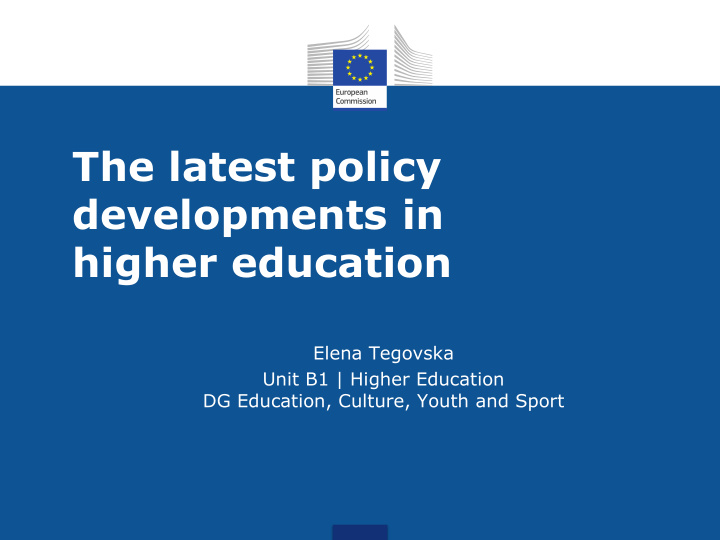



The latest policy developments in higher education Elena Tegovska Unit B1 | Higher Education DG Education, Culture, Youth and Sport
We are working towards a goal
2025 by the European Education Area
learning mobility is a strong sense & research are standard of European unhampered by practice identity borders
Political context European Gothenburg DECEMBER 2017 NOVEMBER 2017 Council Summit Conclusions
Making learning mobility a reality for all
How will we achieve this?
Three key initiatives European Mutual European Student Recognition Universities Card of Diplomas
Automatic Mutual Recognition of diplomas and the outcomes of learning periods abroad
Automatic Mutual Recognition the European Council calls on Member States, the Council and the Commission... to take work forward with a view to … promoting cooperation on… mutual recognition of higher education and school leaving diplomas at secondary education level.”
In a nutshell: The outcomes from a A qualification in one Member learning period abroad State is automatically are automatically and recognised in the others to fully recognised. grant access to further learning. Education and training institutions remain free to make independent decisions on admission to their programmes.
European Student Card
Why? Boost student mobility across Europe Achieve seamless student mobility from one university to another Improve quality of services for students Decrease administrative burden for students and staff
European Student Card Enables students to easily identify themselves Secure exchange of student data Better and faster student services
European Universities A quantum leap to build the learning centres of the future. A flagship project of the European Education Area
European Universities “…strengthen strategic higher education partnerships through the emergence of some twenty “European Universities” by 2024. These bottom-up networks of universities will enable students to obtain a degree by combining studies in several EU countries , and contribute to the international competitiveness of European universities.” - European Council Recommendations 2017
What is a European University? European inter-university campus with student- - optional as centered associated curricula partners -
What will a European University look like post-2025? Transnational, European multidisciplinary Shared and inter-university knowledge - creating long-term strategy ‘Campus’ teams: on education, Bachelor students/teachers/ and possibly Master researchers/society research & PhD innovation
19 Dedicated Cooperation Structures Shared, integrated, long-term strategic vision on education/research/ innovation European Statute European Degree
14 The call is now live ec.europa.eu/programmes/eras mus-plus
15 Award Criteria 25 Relevance 15 Geographical balance Quality of the proposal and implementation 20 Alliance cooperation agreements 20 20 Sustainability and dissemination
22 Next Steps Information Session – web streamed 18/12/2018 28/02/2019 Deadline to apply Spring 2019 Analysis of applications received Preparation of 2 nd call June 2019 09-11/2019 Start of the first 6 European Universities Launch of the 2 nd call 10/2019
16 Tips for applying • Map your vision • Define your mission statement • Choose the right partners • Be creative and innovative! • Apply to the right instrument
17 6 European Universiti es pil 200+ Other Key ot projects Action 2 funds alli anc
The future of Erasmus
Evolution, not revolution More inclusive and accessible ▪ More participatory and focussed on developing EU-awareness ▪ Broader and forward-looking ▪ More international ▪ Simpler and less bureaucratic ▪
30 12 billion EUR to support million people opportunities abroad for 2021 - 2027 more than
Thank You. Any questions?
Recommend
More recommend